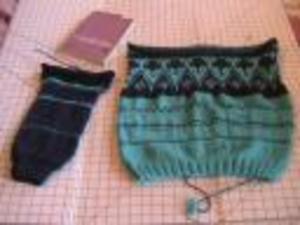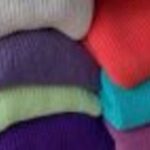Are you ready for the adventure of knitting in more than one color? From simplest to most challenging, here are five color knitting techniques to try.
The simplest way to add more color to knitting is color blocking, a term for knitting various sections of a garment in different colors. An example would be a red, white and blue sweater in which the yoke was red, the sleeves were white, and the body was blue.
Stripes
Another simple way to add color to knitting is to change color at the end of a row (or round, if knitting in the round.) When the right side of your work is facing you, use a slip knot to join the new yarn end around the working yarn. Then drop the working yarn and pick up the new color to knit the next row. After several rows, drop the new color and pick up the old color to knit the next few rows. Continue, always changing colors as you begin a right side row. Carry the unused color loosely up the sides of the work. For wide stripes (more than two inches wide) cut the old yarn and reattach as needed rather than carrying yarn up the side of work.
Duplicate stitch
Duplicate stitch is embroidery done after a piece has been knit in stockinette stitch. Duplicate stitch is done with a tapestry needle and yarn on the knitted surface, following exactly the path of the knit stitches to be covered. The end result is a picture that looks as if it were knit into the fabric. Duplicate stitch is usually worked from a chart, similar to a counted cross-stitch chart.
Fair Isle knitting
If you know how to knit both English and Continental style, you can knit from a fair isle chart carrying one color in your left hand and one in your right. Knit each stitch with the correct color per your chart. Carry the unused yarn loosely behind the work until it is needed again. A good fair isle design uses only two colors per row or round (because knitters have only two hands) and never carries the unused yarn behind more than five stitches (so that there are no long carries across the back of the work.) Two-color knitting done this way is wonderfully warm as well as colorful, since you are creating a double layer of knitting. This makes fair isle knitting popular for ski sweaters.
Intarsia
Knitting in which a color is used in only a small part of a row is done with the intarsia technique. A classic example of intarsia is the argyle sock. Intarsia is worked in rows, not rounds. Each color section requires a separate ball or bobbin of yarn to be wound. As you knit, you change colors by twisting the old color and new color together to prevent holes where the colors change. This is not portable knitting, as all those balls and bobbins must be kept from tangling.
Don’t be afraid to add some color to your knitting. Try each new color knitting technique on a small project such as a dishcloth or pillow before tackling a sweater or afghan. Enjoy experimenting with new ways to mix colors and keep color knitting interesting, challenging, and fun.






